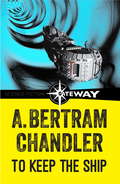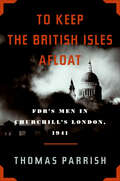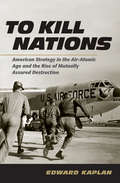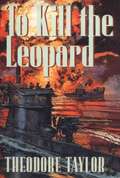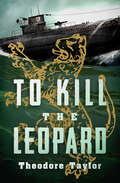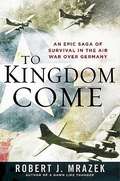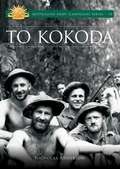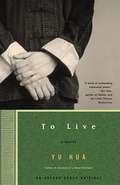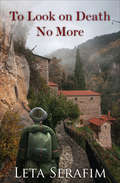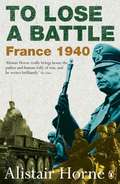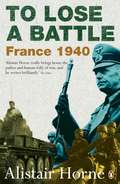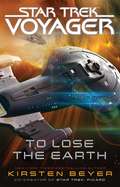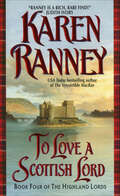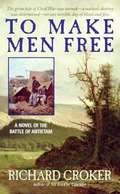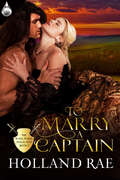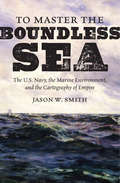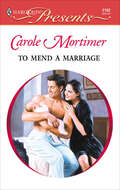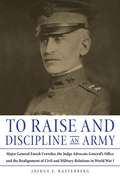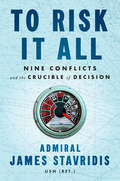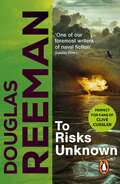- Table View
- List View
To Keep The Ship
by A. Bertram ChandlerJohn Grimes falls into the clutches of terrorists. Its going to talk all his efforts to keep his precious golden ship. (Especially as it is infected with mini-Susies who were sharp-toothed, hungry and ready to eat him alive.)
To Keep The Ship (John Grimes)
by A. Bertram ChandlerJohn Grimes falls into the clutches of terrorists. Its going to talk all his efforts to keep his precious golden ship. (Especially as it is infected with mini-Susies who were sharp-toothed, hungry and ready to eat him alive.)
To Keep the British Isles Afloat: FDR's Men in Churchill's London, 1941
by Thomas Parrish“Thomas Parrish’s account of Anglo-American relations in 1941 is a carefully researched and deftly written slice of history showing FDR’s hidden hand at work. It is a lesson on the virtues of diplomacy.” — Ted Morgan, author of CHURCHILLParrish’s book brings Hopkins and Harriman vividly to life--each was indeed a character, and the author’s perception of FDR’s thinking is exceptionally sensitive. For historians most useful. For the rest of us a very good read, a page turner for me. — Curtis Roosevelt, author of TOO CLOSE TO THE SUN: Growing Up in the Shadow of my Grandparents, Franklin and Eleanor“A vivid portrait of crucial maneuverings in the most crucial yet little-noted of years, Thomas Parrish’s new book…offers a fresh look at how Churchill’s Britain survived while Roosevelt’s America moved ever so slowly toward forming what became the Grand Alliance.” — Jon Meacham, author of FRANKLIN AND WINSTON“In an engaging, and authoritative voice, Thomas Parrish vividly depicts Harry Hopkins and Averell Harriman, and delineates their crucial role in saving Great Britain and, thus, America during the early part of World War II. This book shines a new light on Franklin Roosevelt and his partnership with Winston Churchill” — Will Swift, author of THE KENNEDYS AMIDST THE GATHERING STORM“Plays a valuable role in highlighting an often overlooked period of the Second World War, after the Battle of Britain but before Pearl Harbor, when President Roosevelt struggled to find and implement a policy of all possible material aid and support short of American military involvement and war. — Alan Packwood, Director, The Churchill Archives Centre“Parrish is a skilled writer, adept at conveying an authentic sense of the prevailing atmosphere...1941 is the compelling story here, now illuminated by this account of the successful efforts of two pathfinding American statesmen to help bring the liberal democracies together.” — Fraser Harbutt, Department of History, Emory University, author of The Iron CurtainParrish, the author of several books about World War II, uses Clare Booth to back into his thesis that a sleepy, isolationist America needed to be roused, and that Roosevelt relied on two remarkable men – Hopkins and Harriman – to help sound the alarm and secure aid for Britain. — New York Times Book Review
To Kill Nations: American Strategy in the Air-Atomic Age and the Rise of Mutually Assured Destruction
by Edward KaplanBetween 1945 and 1950, the United States had a global nuclear monopoly. The A-bomb transformed the nation’s strategic airpower and saw the Air Force displace the Navy at the front line of American defense. In To Kill Nations, Edward Kaplan traces the evolution of American strategic airpower and preparation for nuclear war from this early air-atomic era to a later period (1950–1965) in which the Soviet Union’s atomic capability, accelerated by thermonuclear weapons and ballistic missiles, made American strategic assets vulnerable and gradually undermined air-atomic strategy. The shift to mutually assured destruction (MAD) via general nuclear exchange steadily took precedence in strategic thinking and budget allocations. Soon American nuclear-armed airborne bomber fleets shaped for conventionally defined—if implausible, then impossible—victory were supplanted by missile-based forces designed to survive and punish. The Air Force receded from the forefront of American security policy.Kaplan throws into question both the inevitability and preferability of the strategic doctrine of MAD. He looks at the process by which cultural, institutional, and strategic ideas about MAD took shape and makes insightful use of the comparison between generals who thought they could win a nuclear war and the cold institutional logic of the suicide pact that was MAD. Kaplan also offers a reappraisal of Eisenhower’s nuclear strategy and diplomacy to make a case for the marginal viability of air-atomic military power even in an era of ballistic missiles.
To Kill the Leopard
by Theodore TaylorAn account of the hunt for the elusive leopard U-boat as told from both the Allied and German sides.
To Kill the Leopard
by Theodore Taylor&“A high-impact techno-thriller [that] brings readers into the heart of WWII&’s Battle of the Atlantic . . . To Kill the Leopard is a winner.&” —Publishers Weekly The U-boat under Horst Kammerer&’s command bears a leopard insignia, and Kammerer is indeed a feral hunter as he torpedoes Sully Jordan&’s oil tanker. The merchant marine escapes with his life—only to encounter Kammerer again a month after Pearl Harbor. After Jordan loses yet another ship to the German captain, he boards a Q-ship—a decoy packed with weapons—with the intention of becoming predator instead of prey . . . &“The novel sustains interest from first page to last with an exciting story line that climaxes in an enthralling final duel.&” —Publishers Weekly &“Realistic submarine suspense . . . Leaps from scenes aboard a Nazi U-boat to scenes on freighters sailed by American merchant mariner Sully Jordan to scenes in Lorient, France, where the Resistance works against the Occupation.&” —Kirkus Reviews
To Kingdom Come
by Robert J. MrazekThe breathtaking, never-before-told, true story of a historic air force bombing mission in 1943 Germany.
To Kingdom Come
by Robert J. MrazekOn September 6, 1943, three hundred and thirtyeight B-17 "Flying Fortresses" of the American Eighth Air Force took off from England, bound for Stuttgart, Germany, to bomb Nazi weapons factories.Dense clouds obscured the targets, and one commander's critical decision to circle three times through heavy fire would prove disastrous. Forty-five planes went down that day, and hundreds of men were lost or missing.Sharing the first-person accounts of six of the B-17 airmen, award- winning author Robert J. Mrazek vividly re-creates the fierce air battle-and reveals the astonishing valor of the airmen who survived being shot down, and the tragic fate of those who did not.
To Kokoda (Australian Army Campaigns Series #14)
by Nicholas AndersonWhen the Japanese war machine swept through South-East Asia in early 1942, it was inevitable that conflict would reach Australian territory on the island of New Guinea. The ultimate Japanese target was Port Moresby. Conquering the capital would sever communication between Australia and her American ally and allow Japanese air power to threaten Australia&’s northern cities. When a seaborne invasion was thwarted at the Battle of the Coral Sea, the Nankai Shitai landed in Papua on 21 July and lunched an overland attack. Having captured the village of Kokoda with its vital airstrip, the Japanese headed for Port Moresby, traversing the treacherous Kokoda trail that winds across the might Owen Stanley Range. The Australian Army was ill prepared to confront the Japanese. Poorly equipped, undertrained, and unaccustomed to jungle warfare, the untested militia battalions were the first to face the battle-hardened invading forces. Later, when veteran AIF brigades were rushed forward to bolster the militia, they also fell in the path of the Japanese onslaught. But the over-extension of supply lines and disaster on Guadalcanal eventually cruelled Japanese aspirations and the Kokoda campaign became a bloody and protracted struggle as the Australian troops fought to drive the Japanese off the Owen Stanleys and out of Papua. While the front-line troops were engaged in a bitter fight for survival, a power struggle erupted at the top of the Allied command hierarchy resulting in a series of sackings, the competing ambitions of the Allied commanders clouding their judgement at a critical time. It was under these conditions, against a determined enemy and on one of the harshest battlefields on earth, that the Australian forces began to learn the crucial lessons that would be needed to break the back of the Japanese Army in New Guinea.
To Live: A Novel
by Yu HuaOriginally banned in China but later named one of that nation&’s most influential books, a searing novel that portrays one man&’s transformation from the spoiled son of a landlord to a kindhearted peasant. &“A work of astounding emotional power.&” —Dai Sijie, author of Balzac and the Little Chinese SeamstressFrom the author of Brothers and China in Ten Words: this celebrated contemporary classic of Chinese literature was also adapted for film by Zhang Yimou. After squandering his family&’s fortune in gambling dens and brothels, the young, deeply penitent Fugui settles down to do the honest work of a farmer. Forced by the Nationalist Army to leave behind his family, he witnesses the horrors and privations of the Civil War, only to return years later to face a string of hardships brought on by the ravages of the Cultural Revolution. Left with an ox as the companion of his final years, Fugui stands as a model of gritty authenticity, buoyed by his appreciation for life in this narrative of humbling power.
To Look on Death No More
by Leta SerafimDuring WWII, an Irish allied soldier in Greece finds love for a woman, and for a people, as he joins in their tragic fight against the Nazis. In autumn of 1943, a lone allied soldier parachutes into Greece. His stated goal: to build an airstrip for the British. Brendon O'Malley is an Irishman, and though the Nazis are his enemy, that doesn’t necessarily make the British his friends—especially when he discovers they have seriously misled him about his mission. Wounded during the drop, he's set upon and robbed by seventeen-year-old Danae and her little brother, Stefanos. Mistrustful of any foreigner, the two hold him captive in their home in the village of Kalavryta. But despite the mistrust, a wary friendship develops between the three—especially between Brendon and Danae. After his wounds heal, Brendon even joins the Greek resistance, the antartes. But disaster lies just ahead, and the Nazis, already a palpable presence in their lives, stage a savage attack on Kalavryta. Through it all, the love that has grown between Brendon and Danae cannot be extinguished.
To Lose a Battle: France 1940
by Alistair HorneTo Lose a Battle: France 1940 is the final book of Alistair Horne's trilogy, which includes The Fall of Paris and The Price of Glory and tells the story of the great crises of the rivalry between France and Germany. In 1940 Hitler sent his troops to execute the Fall of France. A six-week battle with lightning 'blitzkrieg' warfare and combined operations techniques, the offensive ended the Phony War and sent the French forces reeling as their government fled from occupied Paris. For the Axis, it was a dramatic victory. But how was this spectacular result possible? In To Lose a Battle Alistair Horne tells the day-by-day, moment-by-moment story of the battle, sifted from the vast Nazi archives and the fragmentary records of the beaten Allies. Using eye-witness accounts of battle operations and personal memoirs of leading figures on both sides, this book steps far beyond the confines of military accounts to form a major contribution to our understanding of this important period in European history. 'Alistair Horne really brings home the pathos and human folly of war, and he writes brilliantly' The Times 'Horne follows his line unfalteringly. All the details are there: the small, fleeting triumphs, the greater disasters, the bravery, the cowardice, the stupidity and the intelligence ... that make war so fascinating and so terrible' Economist 'Horne completes his masterly trilogy ... the definitive account of one of the most efficient and astonishing campaigns of all time' The Times Literary Supplement One of Britain's greatest historians, Sir Alistair Horne, CBE, is the author of a trilogy on the rivalry between France and Germany, The Price of Glory, The Fall of Paris and To Lose a Battle, as well as a two-volume life of Harold Macmillan.
To Lose a Battle: France 1940
by Alistair HorneIn 1940, the German army fought and won an extraordinary battle with France in six weeks of lightning warfare. With the subtlety and compulsion of a novel, Horne’s narrative shifts from minor battlefield incidents to high military and political decisions, stepping far beyond the confines of military history to form a major contribution to our understanding of the crises of the Franco-German rivalry.To Lose a Battle is the third part of the trilogy beginning with The Fall of Paris and continuing with The Price of Glory (already available in Penguin).
To Lose the Earth (Star Trek: Voyager)
by Kirsten BeyerThe long-awaited follow-up to Voyager: Architects of Infinity from the New York Times bestselling author and cocreator of Star Trek: Picard! As the crew of the Full Circle fleet works to determine the fate of their lost ship, the Galen, a struggle for survival begins at the far edge of the galaxy. New revelations about Species 001, the race that built the biodomes that first drew the fleet to investigate planet DK-1116, force Admiral Kathryn Janeway to risk everything to learn the truth.
To Love Again: An epic, unputdownable read from the worldwide bestseller
by Danielle SteelTHE WORLD'S FAVOURITE STORYTELLER NEARLY ONE BILLION COPIES SOLD Isabella and Amadeo. The toast of international society and the undisputed leaders of Rome couture. Together they ruled the House of San Gregoria, a monument to Isabella's fabulous designs and stunning beauty, to Amadeo's unerring flair and golden Florentine elegance. And beyond their enchanted world of splendour shone their boundless, undying love for one another.Then suddenly their dream was shattered. Amadeo was gone - for ever. Isabella fled to Rome for a new life of bitter struggles and haunting memories. With her proud courage and all her zest for living, could she ever say goodbye to the past and dare . . . to love again.An epic and romantic tale from one of the best-loved writers of all time. Perfect for fans of Penny Vincenzi, Lucinda Riley and Maeve BinchyPRAISE FOR DANIELLE STEEL:'Emotional and gripping . . . I was left in no doubt as to the reasons behind Steel's multi-million sales around the world' DAILY MAIL'Danielle Steel is undeniably an expert' NEW YORK TIMES
To Love a Scottish Lord: Book Four Of The Highland Lords (The Highland Lords #4)
by Karen RanneyA Lord Not Meant to MarryHamish MacRae, a changed man, returned to his beloved Scotland intending to turn his back on the world. The proud, brooding lord wants nothing more than to be left alone, but an unwanted visitor to his lonely castle has defied his wishes. While it is true that this healer, Mary Gilly, is a beauty beyond compare, it will take more than her miraculous potions to soothe his wounded spirit. But Mary's tender heart is slowly melting Hamish's frozen one . . . awakening a burning need to keep her with him -- forever.A Lady Who Dares Not LoveNever before has Mary felt such an attraction to a man! The mysterious Hamish MacRae is strong and commanding, with a face and form so handsome it makes Mary tremble with wanting him. Already shadowy forces are coming closer, heartless whispers and cruel rumors abound, and it will take a love more pure and powerful than any other to divine the truth -- and promise a future neither had dreamed possible.
To Make Men Free
by Richard CrokerIt was the battle that altered the tides of war ... and the fate of a nation. On September 17, 1862, in Sharpsburg, Maryland, more than 23,000 Union and Confederate soldiers were killed or wounded, making the Battle of Antietam the bloodiest day in American history. Robert E. Lee must act as a general when his youngest son pleads not to be sent "back in there." Confederate General A. P. Hill arrives on the field at the last possible moment with something to prove to his former West Point roommate, Union General George McClellan, while Abraham Lincoln desperately struggles with the issue of emancipation of the slaves. Much of the battle is seen through the eyes of Stonewall Jackson's young adjutant, Kyd Douglas, and a little-known reporter named George Smalley, who scoops the competition with his vivid account of the battle. From the White House to the battlefield, this immaculately researched novel masterfully re-creates the day that dashed Southern hopes for a quick victory and paved the way for Lincoln's most enduring legacy -- the Emancipation Proclamation.
To Make Men Free: A Novel Of The Civil War
by Newt Gingrich William R. Forstchen Albert S. HanserWith To Make Men Free(originally published as The Battle of the Crater), New York Times bestselling authors Newt Gingrich and William R. Forstchen take readers to the center of a nearly forgotten Civil War confrontation, a battle that was filled with controversy and misinterpretation even before the attack began. June 1864: the Civil War is now into its fourth year of bloody conflict with no end in sight. James O'Reilly--famed artist, correspondent, and former companion of Lincoln--is summoned discreetly to a meeting with the President. His old friend gives him a difficult assignment: travel to the trenches outside of Richmond to be Lincoln's eyes and ears amongst the men, sending back an honest account of the front. Meanwhile, General Ambrose Burnside, a hard luck commander out of favor with his superiors, has an ingenious plan to break through the closest point on the Confederate line by tunneling forward from the Union position beneath the fort to explode its defenses. The risks are high, and Burnside needs a brave division of the United States Colored Troops for one desperate rush that just might bring victory. As the battleground drama unfolds, this must-read work rewrites our understanding of one of the great battles of the war, providing a sharp, rousing and harshly realistic view of politics and combat during the darkest year of the Civil War.
To Make a Marriage (Bachelor Sisters Ser. #3)
by Carole MortimerHow much longer could Andie keep her pregnancy a secret? Both her sisters knew, and soon she would start to show!Andie was fiercely determined to bring up her child-alone. The conception had taken place in a moment of madness, with a man whom Andie was convinced was in love with another woman.However, Adam Munroe was also a close family friend and Andie knew she couldn't avoid him forever....
To Marry a Captain
by Holland RaeSince the passing of her estranged husband, Lady Amalie Bronwyn has been living at the Dacre Estate, a place with a reputation as the most debauched house in all of England. Albeit reformed, since Lady Amalie's cousin Mary became engaged to the estate's notorious owner, Lord Arlington, Dacre is where she fits in perfectly. After all, her own reputation is a fair bit more colorful than most, boasting of public dalliances and seductions that have turned society on its head, and Lady Amalie likes that just fine. She prefers her independence and freedom to the strictures of marriage and domestic responsibility. But a single letter from her father and the life she has been enjoying crashes to an end--her fiancé is coming home. After a routine navy training exercise turns into a bloody battle between soldiers and pirates, Captain Malcolm Temple-Blackwood, Lord of Huntley, is sent on a mandatory holiday to cool his heels in the throes of domestic bliss. He knows nothing about the woman his father arranged for him to wed, but his orders are clear--unless he can make a convincing performance of his matrimonial rapture, he'll never step foot on a ship again. What he needs is a quiet, well-behaved, sweet wife, someone who will help him to regain his position in the navy. What he gets is something else entirely.
To Master the Boundless Sea: The U.S. Navy, the Marine Environment, and the Cartography of Empire (Flows, Migrations, and Exchanges)
by Jason W. SmithAs the United States grew into an empire in the late nineteenth century, notions like "sea power" derived not only from fleets, bases, and decisive battles but also from a scientific effort to understand and master the ocean environment. Beginning in the early nineteenth century and concluding in the first years of the twentieth, Jason W. Smith tells the story of the rise of the U.S. Navy and the emergence of American ocean empire through its struggle to control nature. In vividly told sketches of exploration, naval officers, war, and, most significantly, the ocean environment, Smith draws together insights from environmental, maritime, military, and naval history, and the history of science and cartography, placing the U.S. Navy's scientific efforts within a broader cultural context.By recasting and deepening our understanding of the U.S. Navy and the United States at sea, Smith brings to the fore the overlooked work of naval hydrographers, surveyors, and cartographers. In the nautical chart's soundings, names, symbols, and embedded narratives, Smith recounts the largely untold story of a young nation looking to extend its power over the boundless sea.
To Mend a Marriage
by Carole MortimerGemini’s marriage of convenience to Nick Drummond had gone terribly wrong the moment she’d fallen in love with her husband. She desired Nick so much—but as theirs was a marriage in name only, she could only look, not touch. However, when Gemini found herself looking after her tiny baby niece—dumped on her by her irresponsible twin sister—a way to mend her marriage became clear....
To Raise and Discipline an Army: Major General Enoch Crowder, the Judge Advocate General’s Office, and the Realignment of Civil and Military Relations in World War I
by Joshua KastenbergMajor General Enoch Crowder served as the Judge Advocate General of the United States Army from 1911 to 1923. In 1915, Crowder convinced Congress to increase the size of the Judge Advocate General's Office—the legal arm of the United States Army—from thirteen uniformed attorneys to more than four hundred. Crowder's recruitment of some of the nation's leading legal scholars, as well as former congressmen and state supreme court judges, helped legitimize President Woodrow Wilson's wartime military and legal policies. As the United States entered World War I in 1917, the army numbered about 120,000 soldiers. The Judge Advocate General's Office was instrumental in extending the military's reach into the everyday lives of citizens to enable the construction of an army of more than four million soldiers by the end of the war. Under Crowder's leadership, the office was responsible for the creation and administration of the Selective Service Act, under which thousands of men were drafted into military service, as well as enforcement of the Espionage Act and wartime prohibition. In this first published history of the Judge Advocate General's Office between the years of 1914 and 1922, Joshua Kastenberg examines not only courts-martial, but also the development of the laws of war and the changing nature of civil-military relations. The Judge Advocate General's Office influenced the legislative and judicial branches of the government to permit unparalleled assertions of power, such as control over local policing functions and the economy. Judge advocates also altered the nature of laws to recognize a person's diminished mental health as a defense in criminal trials, influenced the assertion of US law overseas, and affected the evolving nature of the law of war. This groundbreaking study will appeal to scholars, students, and general readers of US history, as well as military, legal, and political historians.
To Risk It All: Nine Conflicts and the Crucible of Decision
by Admiral James StavridisFrom one of the great naval leaders of our time, a master class in decision-making under pressure through the stories of nine famous acts of leadership in battle, drawn from the history of the United States Navy, with outcomes both glorious and notoriousAt the heart of Admiral James Stavridis&’s training as a naval officer was the preparation to lead sailors in combat, to face the decisive moment in battle whenever it might arise. In To Risk it All, he offers up nine of the most useful and enthralling stories from the US Navy&’s nearly 250-year history, and draws from them a set of insights that we can all put to use when confronted with fateful choices. Conflict. Crisis. Risk. These words have a distinct meaning in a military context that we hope will never apply identically in our own lives. But at the same time, as Admiral Stavridis shows with great clarity, many lessons are universal. To Risk it All is filled with thrilling and heroic exploits, but it is anything but a shallow exercise in myth burnishing. Every leader in this book has real flaws, as all humans do, and the stories of failure, or at least the decisions that have been defined as such, are as crucial as the stories of success. In the end, when this master class is concluded, we will be better armed for hard decisions both expected and not.
To Risks Unknown: an all-action tale of naval warfare set at the height of WW2 from the master storyteller of the sea
by Douglas ReemanMulti-million copy bestselling author Douglas Reeman is the master of naval fiction and this action-packed, high-octane WW2 historical adventure is no exception. Jam-packed with tension, drama and all-guns-blazing warfare, it's perfect for fans of Clive Cussler, Bernard Cornwell and Wilbur Smith.'One of our foremost writers of naval fiction' - Sunday Times'Just superb!!!' -- ***** Reader review'Such a joy to read' -- ***** Reader review'Kept me gripped' -- ***** Reader review'Hard to put down while reading' -- ***** Reader review***********************************************************************************1943: Now there is to be no more retreat for Britain and her Allies.At last the war is to be carried into enemy territory. From captured bases and makeshift harbours in North Africa, The Royal Navy's Special Force is to be the probe and the spearhead of the advance.To this unorthodox war come H. M. S. Thistle and her commanding officer, John Crispin. Both veterans, she from the Atlantic, he from the trauma of seeing his last command and her company brutally destroyed. Soon they are fighting amongst remote Adriatic islands - helping the partisans and guerrillas with whom they have little in common, except an overwhelming common hatred of the enemy who has attacked and destroyed their countries.When it comes to the crunch, ship and crew have to be welded into a single fighting unit. And it has to be done, not in training, but on active duty.
